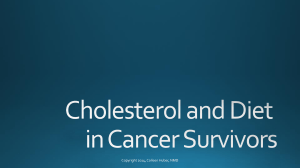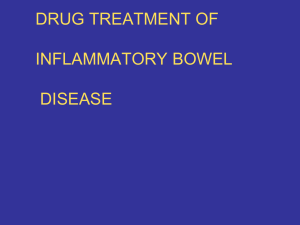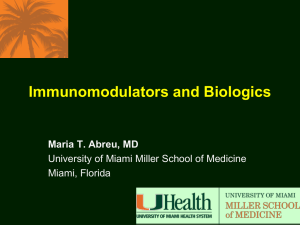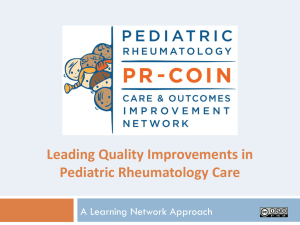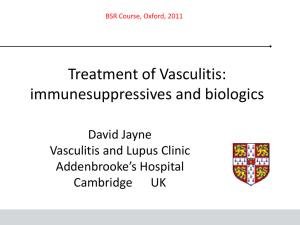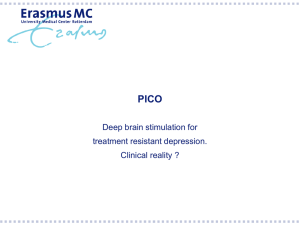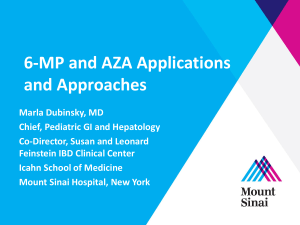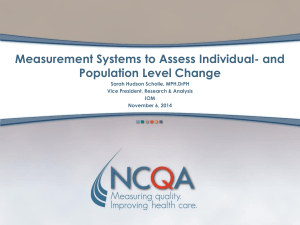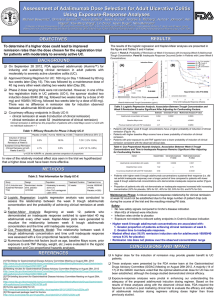Crohn`s Disease (CD)and current Therapies
advertisement
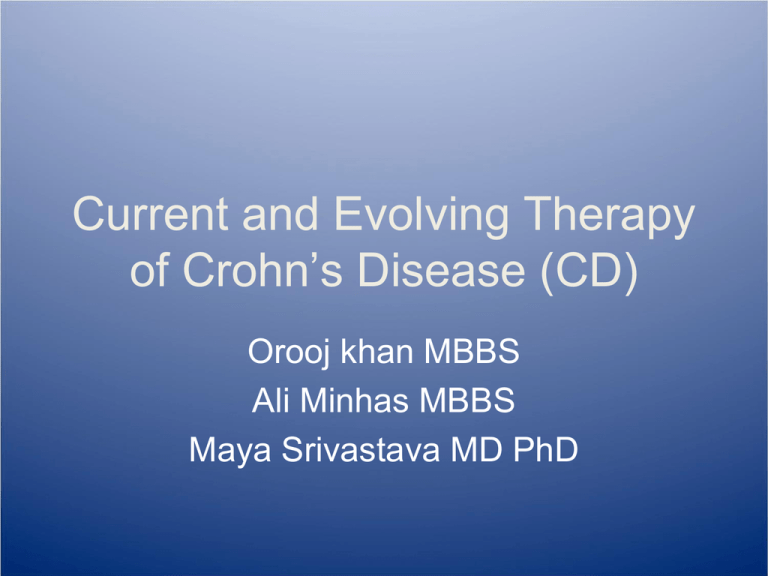
Current and Evolving Therapy of Crohn’s Disease (CD) Orooj khan MBBS Ali Minhas MBBS Maya Srivastava MD PhD Introduction • Crohn's disease (CD) is a chronic inflammatory disorder of the digestive tract with a wide spectrum of clinical presentations and an unpredictable disease course. • The estimated annual prevalence is 50 per 100,000 • The estimated annual incidence of CD is five per 100,000 • CD is more prevalent in Western countries • Affects all age groups, but is more commonly diagnosed in adults during the second and third decades of life. Introduction • Patients are faced with a lifetime of recurrent disease flare-ups and remission • CD remains medically and surgically incurable (despite advancements in understanding its etiology and pathogenesis) • Management strategies must be targeted towards lifelong management (both short- and long-term aspects of the disease). Changing Standards… • The ultimate goal is Inducing and Maintaining clinical remission • The current standard medical practice-‘Step-up'–sequential approach by using first-line agents (aminosalicylates [5-ASA], corticosteroids, and antibiotics), then immunomodulators and then biological therapy. • This approach does successfully treat the acute disease, and maintains remission, but does not alter the long-term course of CD. • The question- “Is it possible to alter the natural history of CD?” by an early introduction of therapies currently reserved for the 'top' (i.e.'top-down' approach). • We aim to present the rationale for the use of 'top-down' versus 'step-up' therapy for the treatment of CD. Natural history of CD • Intermittent exacerbation of symptoms alternating with periods of quiescence • A cohort study from Scandinavia by Munkholm et al. demonstrated: -13% of patients will achieve complete remission -20% of patients will experience annual relapse -67% will have a combination of relapse and remission within the first 8 years after initial diagnosis. • In a population-based cohort study, Silverstein et al found that a CD patient spends: -24% of the time in medical remission without medications -41% of the time in postsurgical remission without medications -7% of the time in medical treatment with 5-ASA derivatives -7% of the time having disease activity mandating treatment with corticosteroids or immunomodulators. Disabling course…. • A population-based study from Olmsted County, MN, USA by Schwartz et al. demonstrated: • Risk for the development of fistulas was 33% at 10 years and 50% after 20 years • The majority (83%) of fistulae required a surgical approach • Recurrence rate of perianal fistulae has been reported to be as high as 59-71% • presence of perianal disease, younger age of disease onset, need for corticosteroids predict a disabling course (85% of patients developed a disabling course within 5 years of diagnosis). (Beaugerie et al.) Current Available Therapies • The First-Line therapies: 1) 5-ASA (not FDA approved)-exert their therapeutic effect topically within the intestinal lumen. -include the slow-release formulations -A Cochrane systematic review ( 6 randomized placebo controlled trials with 12-month follow-up) demonstrated no superiority of 5-ASA over placebo in maintaining remission of CD First Line Therapies 2) Antibiotics (not FDA approved): -Metronidazole and ciprofloxacin are the most widely used -Can be used alone or in combination . -In a Scandinavian Trial Metronidazole was found to be equally efficacious to sulfasalazine -Data are limited on the efficacy of antibiotics as maintenance therapy . -Potentially serious side effects (peripheral neuropathy and tendinitis or tendon rupture) 3) Budesonide (oral)- controlled-release • high topical activity and low-systemic bioavailability • used in patients with mild-to-moderately active CD involving the ileum and/or right colon. • No evidence for the use of budesonide in fistulizing disease. • Not recommended as a maintenance treatment for CD. Second-line therapy (Systemic corticosteroids) • Highly effective in achieving clinical remission. • A population-based cohort study observed that 84% of patients had either complete or partial response. • But, within 1-year , 28% of patients with CD became corticosteroid-dependent • 38% of CD patients underwent surgery • Increased risk of significant side effects, so long-term use is not recommended Third-line therapy (immunomodulators & methotrexate) • AZA and 6-MP • Effective in maintaining clinical remission with steroid sparing effect • Slow onset of action of 3-6 months precludes their use as inductive agents • Serious side effects associated with the prolonged use of these medications- non-Hodgkin lymphoma and hepatosplenic T-cell lymphoma • . • Methotrexate • MTX was three-times more efficacious than placebo in maintaining remission of CD (Cochrane database meta-analysis of (3 randomized placebo-controlled trials) • Potential adverse events- liver fibrosis, pneumonitis and bone marrow suppression • Therefore the optimal duration of maintenance therapy remains unknown The fourth-line therapy: anti-TNF (infliximab, adalimumab & certolizumab pegol) • Designed to block or neutralize proinflammatory cytokines 1) Infliximab (FDA approved) • For induction and maintenance therapy in patients with moderate-tosevere CD refractory to conventional therapies (ACCENT I trial) • Effective in reducing the number of draining fistulae and maintaining fistula closure • • • • • • Maintenance therapy was associated with: higher clinical response and remission rates significant reduction in hospitalizations and surgical procedures prolonged mucosal healing, faster steroid weaning, better quality of life. 2) Adalimumab- monoclonal anti-TNF antibody of fully human origin (Approved by the FDA in 2007) • As an induction agent (CLASSIC I trial) • A maintenance agent (CLASSIC II and CHARM trials) in adult patients unresponsive to conventional therapy • Patients intolerant to or lost response to infliximab • Patients with fistulizing CD treated with adalimumab had a significantly decreased number of draining fistulae per day (CHARM trial) • • • • 3) Certolizumab pegol (FDA approved 2008) High binding affinity for TNF-alpha. Effective in inducing clinical response (PRECISE I trial) Maintaining Remission (PRECISE II trial) Not more efficacious on fistula closure (either of the mentioned trials). Medical therapy for the nonresponders: selective adhesion molecule inhibitors (natalizumab) • Natalizumab - new class of biologic agents (approved by the FDA in 2008 • Targeted against the [alpha]4 subunit of integrin molecules • Treatment to induce clinical response ENCORE trial • Maintain Remission ENACT 2 trial • Only in patients who had inadequate response or intolerance to conventional CD therapies, including the anti-TNF-[alpha] agents. • Approved for use only as a monotherapy owing to an underlying risk of PML. So which one is better? Step-up versus top-down • Step-up therapy • Refers to a sequential treatment strategy • Begins with a less effective, potentially less toxic treatment strategy, ( aminosalicylates, antibiotics or budesonide) • Escalation to the highly effective but potentially more toxic treatment (prednisone, immunomodulators and biological therapy) • In this strategy-avoid overtreating and unnecessary exposure to the risk of developing adverse events. • For the reason of toxicity, physicians are often reluctant to advance therapy (may result in inadequate treatment and prolonged inflammation). • Top-down therapy • Many studies have shown that most patients treated with the conventional step-up therapy go on to develop stricturing or penetrating disease . • UK Study- looked at the influence of (infliximab) on resources in CD and found: • There were fewer bed days and number of abdominal operations was halved (Jewell et al) • ACCENT I trial- demonstrated significant mucosal healing in 73% of patients treated early imunosuppression. • There was a greater proportion of patients who achieved early clinical remission at week 14 (p = 0.0001) and week 26 (60 vs 36%; p = 0.0062) • A significant difference- number of patients in remission without corticosteroids and without surgery at weeks 26 and 52. • Safety issues remain a major concern in the top-down approach. • Increased risk of TB, opportunistic infections and malignancy. • The risks of lymphoma and hepatosplenic T-cell lymphoma have been found to be associated with long-term immunomodulator use. • The cost for initiating treatment may be higher in patients receiving early combination therapy • But take account indirect costs- as cost of lost productivity, quality of life, hospitalization and surgery rate, • 1-year data from the recent SONIC trial have shown that monotherapy with infliximab or combination therapy consisting of infliximab and AZA are more likely to maintain long-term corticosteroid-free remission than monotherapy with AZA Whom & when to treat? • There are no simple answers • Our ability to risk stratify patients remains rudimentary • Identify clinical factors associated with a disabling course and certain genetic and serologic profiles that may require a more aggressive therapy • The real challenge- development of an improved classification system (identify subgroups to maximize the treatment benefit-risk profile). The Future….. • Need to improve our ability to assess prognosis at the time of diagnosis, personalize treatment and target the patients will develop complicated disease • we hope to invert the treatment pyramid in selected target populations • Goals of disease modification, mucosal healing, reduced pharmacoeconomics, • Improved quality-of-life


